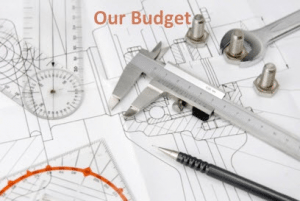Reverse engineering (the process of starting with a product and taking it apart to see how it works) has been used in product development for decades. Many organizations use this as a best practice in copying some key product or concept from a competitor. When applied to a process, it is the practice of starting with the end-game (what you ultimately want to achieve) and then determining what it would take to reach that end-game or result. It can be a valuable exercise in improving a broken or flawed process.
Budgeting has become “mission critical” in most organizations that are serious about financial performance, cost control and making sure that they fund the strategy of the organization as opposed to budgeting to history or politics. Budgeting is currently a very flawed process.
Reverse engineering can be easily applied to this “mission critical” process as well. One only need imagine what a desired budget process would entail and then attempt to come up with a plan for how to achieve it.
For instance, in a desired world:
- Managers would not have to know very much about either systems or budgeting in order to create a meaningful budget.
- Managers would be actively engaged in the budget process and have ownership of the numbers and the results.
- Managers would have the freedom and flexibility to budget their departments the way they think about those departments.
- Monthly values would be easily calculated for each annual number based on user controlled decisions about that number.
- There would be specific functionality to handle the complexity of salary/headcount planning and benefits; and managers would be able to easily request specific asset purchases for the following fiscal year. In both cases the process would properly account for both the people and the assets, and provide clear visibility for the plan going forward – without any additional work.
- Managers could easily prepare and review budgets from anywhere.
- Approval workflow and audit trails would be automatically and easily applied to the process.
- Errors would be eliminated or dramatically reduced in the preparation process.
- All assumptions, documentation and justification of numbers would be easily applied – and this documentation would follow the numbers throughout the approval and reporting process.
- There would be no redundant data entry.
- Consolidation would occur naturally.
- The budget process would be electronically integrated with the general ledger, payroll and fixed asset systems to provide proper data flow.
- All budget questions could be easily addressed through flexible, and easy to maintain, reporting and analysis.
- Structured and practical “what-if’s” that address 90% of user needs would be easily incorporated.
- The process would easily accommodate updates to the budget throughout the evolving fiscal year–to deal with the actual results and reality of budget adjustments based on real-life events.
When you start with what you want to have happen and then seek solutions to address those criteria, building a better budget process becomes remarkably easy. Understanding the needs of all the major constituents in the budget process is another key to success. These constituencies are management, finance, department heads and IT.
However, one critical mistake that many organizations make is they focus on features rather than results. And they start (and end) with a list of budget and forecast software features that deals only with the needs of finance, and not the desired outcomes for budget managers or the organization’s management. This leads to an overly complex and theoretical RFP process, or a checklist process that ignores the central issues of budgeting. And this leads to feature fights without regard to the usability or even the practicality of the feature – and also without regard to the usability or practicality of the system in general. Often, a long list of features that will NEVER actually be put into use is what sways financial teams.
The most important constituent in the budget process is not finance, nor even management. To build a better budget process, and to select budgeting software that fulfills your goals, you need to first consider the needs of the department heads. Most of the current problems with budgeting are that the department head’s needs are not properly accounted for – but when they are, ease of use, flexibility, ability to document their assumptions and justify their requests, and helping them understand what they are trying to accomplish with the budget become the primary drivers. If budgeting is a financial function, why are 80% to 90% of the users non-financial people? And, budgeting is as much a communications process as it is a financial one.
So beginning with complaints or needs of constituents can be enormously valuable. Here are the results of what a recent survey said about the primary complaints of these constituents about their current budget process. It is important to note that the vast majority of respondents worked in organizations that used Microsoft Excel for budgeting:
Management
- The budget does not tie to the organizational strategy.
- I can’t get my questions answered in a timely fashion.
- The process takes too long.
- I worry about quality of information.
Finance
- Department heads don’t put sufficient time and energy into their budgets.
- I worry about errors (formulas) and redundant data entry.
- I don’t want to be an Excel programmer or manually manage data.
- Department heads keep changing budget templates.
Department Heads
- The budget templates don’t let me budget my department the way I think about my department.
- The process is too cumbersome and rigid.
- I don’t feel like the numbers are mine.
IT
- I don’t like Excel-based processes.
- There’s no structured data management, audit trails, checks.
- I don’t want to manage another system… would prefer if this moved to the cloud.
In support of the need to focus on the usability needs of department heads, consider some quotes from a recent WSJ article on business applications:
At a time when people are accustomed to using well-designed applications from companies such as Google Inc. and Apple Inc. in their personal lives, they have little patience for workplace applications that leave them confused. Functionality is no longer the definition of success. Usability is key.
“Basically, users will accept less crap today, when it comes to software,” says Michael Krigsman, an independent industry analyst. “That is because the world of consumer software has become easy and simple to use and has trained users to expect that business software will follow a similar model. And if it doesn’t, people are much less patient than they were in the past.”
Reverse engineering the budget process is an excellent way of ensuring that you radically improve the process going forward. But taking the primary needs of ALL BUDGET USERS into consideration and including the most important constituents into the reverse engineering process is essential to success.
Building a better budget process for better financial results can be an easy and inexpensive process in most organizations if the organization has the motivation, confidence and discipline to do so.
To learn more about best practices that will improve your budgeting process listen to our podcast: The 10 Commandments of Budgeting.

